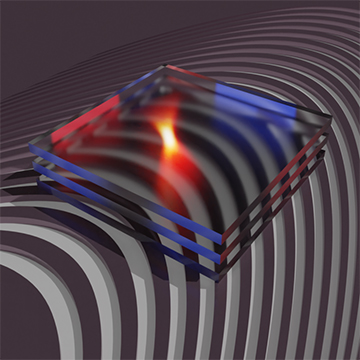
A team at the Max Born Institute for Nonlinear Optics, Germany, used a laser-driven, lab-scale source of soft X-rays to investigate scattering behavior and dynamics in an antiferromagnetic material—a class of materials considered intriguing for next-gen computer storage systems. [Image: Moritz Eisebitt]
Resonant magnetic X-ray scattering in the soft X-ray range (around 700 eV) has been the exclusive domain of building-sized synchrotron light sources. Now, researchers based in Germany have used a laser-driven, laboratory-sized source of these photons to study the ultrafast dynamics of an antiferromagnetic lattice (Optica, doi:10.1364/OPTICA.435522).
This study of an antiferromagnet—a magnetically ordered material with vanishing total magnetism—required a sufficiently large photon flux in the soft X-ray range with pulse durations of less than 10 ps, according to Daniel Schick, a physicist at the Max Born Institute for Nonlinear Optics and Short-Pulse Spectroscopy in Berlin, Germany.
The lab, with many years of experience in laser-driven plasma physics, had already developed a room-sized photon source for soft X-ray spectroscopy—but not for scattering, Schick says. “However, we moved it into a complete new lab and redesigned the whole beamline from scratch to meet the requirements for this demanding experiment,” he adds.
Schematic setup of the magnetic scattering experiment. The structure of the investigated artificial antiferromagnet is sketched in the top right corner. [Image: Max Born Institute] [Enlarge image]
From infrared to X-ray
For the origin of the beamline, Schick and his colleagues built a thin-disk amplified laser producing high-energy near-infrared pulses at a 100-Hz repetition rate. The laser beam shone into a vacuum chamber, where it was focused onto a rotating tungsten cylinder at a 45-degree angle to the beam. This meeting of light and tungsten produced a plasma that emitted broadband X-ray radiation between 50 and 1500 eV.
According to Schick, the group’s main challenge was to generate and bring as many photons as possible to the sample. “Our soft-X-ray source is generally rather bright, but at the same time comparable to a light bulb, so it emits a broad spectrum of short soft-X-ray pulses in all directions,” he says.
One research team member, Alexander Firsov of the Helmholtz Center Berlin, Germany, designed a custom reflection zone-plate to perform the all-in-one duty of collecting, dispersing, and focusing the X-rays from the plasma source onto an adjustable slit, which extracted only a small range of energies of interest (695–735 eV) to pass through to, and scatter off, the antiferromagnetic superlattice. A CCD camera at the end of the chain detects the scattered light.
Enough photons for the experiment
Schick and his colleagues realized a photon flux of 1.2×106 photons per second per electron volt at the sample—a first for a laboratory-sized source of this type. Schick noted that his team could have done the work at a storage-ring synchrotron or a free-electron laser, but only a handful of such light sources have the experimental stations needed to carry out such time-resolved resonant magnetic scattering experiments on antiferromagnets. “This renders it nearly impossible to do real systematic studies on relevant physical problems on ultrafast time scales in this material class,” he adds.
The results fall into the categories of basic science and proof of concept, but Schick hopes that the work will enable more applied studies of antiferromagnetic materials. Some researchers consider these materials to be promising candidates for improved data processing and storage components for tomorrow’s computers.

